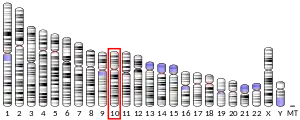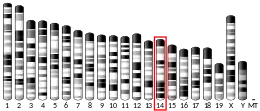Growth differentiation factor 10 (GDF10) also known as bone morphogenetic protein 3B (BMP-3B) is a protein that in humans is encoded by the GDF10 gene.[5]
GDF10 belongs to the transforming growth factor beta superfamily that is closely related to bone morphogenetic protein-3 (BMP3). It plays a role in head formation and may have multiple roles in skeletal morphogenesis.[5][6] GDF10 is also known as BMP-3b, with GDF10 and BMP3 regarded as a separate subgroup within the TGF-beta superfamily.[5]
In mice, GDF10 mRNA is abundant in the brain, inner ear, uterus, prostate, neural tissues, blood vessels and adipose tissue with low expression in spleen and liver. It is also present in bone of both adults and neonatal mice.[5] Human GDF10 mRNA is found in the cochlea and lung of foetuses, and in testis, retina, pineal gland, and other neural tissues of adults.[7]
References
- 1 2 3 GRCh38: Ensembl release 89: ENSG00000266524 - Ensembl, May 2017
- 1 2 3 GRCm38: Ensembl release 89: ENSMUSG00000021943 - Ensembl, May 2017
- ↑ "Human PubMed Reference:". National Center for Biotechnology Information, U.S. National Library of Medicine.
- ↑ "Mouse PubMed Reference:". National Center for Biotechnology Information, U.S. National Library of Medicine.
- 1 2 3 4 Cunningham NS, Jenkins NA, Gilbert DJ, Copeland NG, Reddi AH, Lee SJ (1995). "Growth/differentiation factor-10: a new member of the transforming growth factor-beta superfamily related to bone morphogenetic protein-3". Growth Factors. 12 (2): 99–109. doi:10.3109/08977199509028956. PMID 8679252.
- ↑ Hino J, Kangawa K, Matsuo H, Nohno T, Nishimatsu S (2004). "Bone morphogenetic protein-3 family members and their biological functions". Front Biosci. 9 (1–3): 1520–9. doi:10.2741/1355. PMID 14977563.
- ↑ Katoh Y, Katoh M (2006). "Comparative integromics on BMP/GDF family". Int J Mol Med. 17 (5): 951–5. doi:10.3892/ijmm.17.5.951. PMID 16596286.
Further reading
- Davila S, Froeling FE, Tan A, et al. (2010). "New genetic associations detected in a host response study to hepatitis B vaccine". Genes Immun. 11 (3): 232–8. doi:10.1038/gene.2010.1. PMID 20237496.
- Ducy P, Karsenty G (2000). "The family of bone morphogenetic proteins". Kidney Int. 57 (6): 2207–14. doi:10.1046/j.1523-1755.2000.00081.x. PMID 10844590.
- Grupe A, Li Y, Rowland C, et al. (2006). "A scan of chromosome 10 identifies a novel locus showing strong association with late-onset Alzheimer disease". Am. J. Hum. Genet. 78 (1): 78–88. doi:10.1086/498851. PMC 1380225. PMID 16385451.
- Hino J, Takao M, Takeshita N, et al. (1996). "cDNA cloning and genomic structure of human bone morphogenetic protein-3B (BMP-3b)". Biochem. Biophys. Res. Commun. 223 (2): 304–10. doi:10.1006/bbrc.1996.0889. PMID 8670277.
- Zhou M, Lucas DA, Chan KC, et al. (2004). "An investigation into the human serum "interactome"". Electrophoresis. 25 (9): 1289–98. doi:10.1002/elps.200405866. PMID 15174051. S2CID 42449980.
- Strausberg RL, Feingold EA, Grouse LH, et al. (2002). "Generation and initial analysis of more than 15,000 full-length human and mouse cDNA sequences". Proc. Natl. Acad. Sci. U.S.A. 99 (26): 16899–903. Bibcode:2002PNAS...9916899M. doi:10.1073/pnas.242603899. PMC 139241. PMID 12477932.
- Kimura K, Toyooka S, Tsukuda K, et al. (2008). "The aberrant promoter methylation of BMP3b and BMP6 in malignant pleural mesotheliomas". Oncol. Rep. 20 (5): 1265–8. doi:10.3892/or_00000139. PMID 18949431.
- Lafont JE, Talma S, Hopfgarten C, Murphy CL (2008). "Hypoxia promotes the differentiated human articular chondrocyte phenotype through SOX9-dependent and -independent pathways". J. Biol. Chem. 283 (8): 4778–86. doi:10.1074/jbc.M707729200. PMID 18077449.



